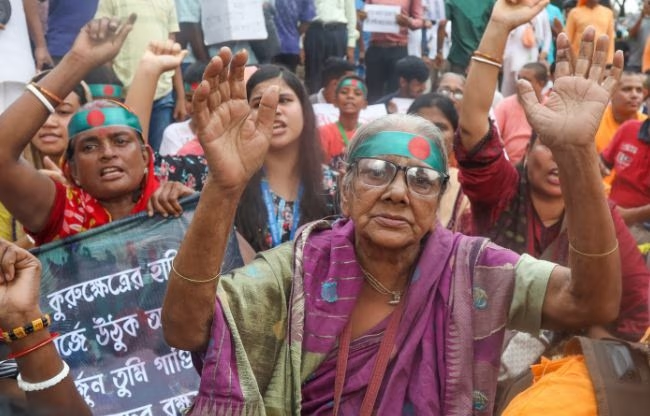Until two weeks ago, Hindus in Bangladesh felt relatively safe. However, since the fall of Sheikh Hasina's government on August 5, fear has gripped their community. Hindus have been attacked, temples desecrated, shops looted, and people threatened.
The National Hindu Grand Alliance of Bangladesh claims that since Hasina's resignation, there have been reports of attacks on Hindus and minorities in 278 locations across 48 districts. The alliance calls it an 'attack on Hinduism'.
Some argue that those being attacked are linked to Hasina's Awami League or have connections to the police. However, three out of every five Hindus killed had no political or police affiliations. Anupam Roy from Dhaka shares that he knows many victims who were far removed from politics.
The Bangladesh Hindu-Buddhist-Christian Unity Council reports that from August 5-8, there were 205 reported cases of attacks on Hindus.
What is the situation in Bangladesh?
Bangladesh has a long history of targeting minorities, especially the Hindu community. Just two years ago, anti-Hindu sentiments erupted, resulting in the murder of several Hindus.
Recently, following Hasina's resignation, numerous attacks on Hindus have been reported. ISKCON temples and Durga temples have been targeted. Hindu homes and shops have been vandalized, and even a cremation ground in Dinajpur was taken over by rioters.
The global community has expressed concern over the violence against Hindus. When Mohammad Yunus was sworn in as interim government head on August 8, Indian Prime Minister Narendra Modi congratulated him and urged him to ensure the safety of Hindus. Modi also addressed the violence against Hindus during India's Independence Day speech, emphasizing the concern of 1.4 billion Indians about the safety of Hindus and other minorities in Bangladesh.
Though recent violence against Hindus is being reported, their persecution has been ongoing for decades. The Hindu American Foundation claims that over 10 million Hindus have fled Bangladesh between 1964-2013. The foundation also notes that 230,000 Hindus leave Bangladesh every year.
Related:

Source: aajtak
The Concern Over the Situation of Hindus in Neighboring Countries
India's three neighbors - Pakistan, Bangladesh, and Afghanistan - once had significant Hindu populations. Now, their numbers are dwindling rapidly.
What does the data say? Let's take a closer look. In 1947, when Pakistan was divided into West and East Pakistan (current Bangladesh), the Muslim population was 85.8% and non-Muslims 14.2%. In West Pakistan, the non-Muslim population was just 3.44%, whereas, in East Pakistan, it was 23.2%.
By 1972, after the creation of Bangladesh, the non-Muslim population in Pakistan had decreased to 3.25%. In the 2017 census, non-Muslims made up 3.53% of Pakistan's population, including Hindus, Christians, Sikhs, Ahmadi Muslims, and others.
In Bangladesh, the non-Muslim population has significantly declined. In 1951, non-Muslims constituted 23.2%. By the 2011 census, this had dropped to 9.4%.
According to Al Jazeera, the Hindu and Sikh population in Afghanistan was over 700,000 in the 1970s. Now, it is less than 7,000.
A 2018 report by the U.S. State Department mentioned that only 700 Hindu and Sikh families remained in Afghanistan. These numbers were recorded before the Taliban's return to power in August 2021, after which many more Hindus and Sikhs fled to India. Currently, over 99% of Afghanistan's population is Muslim, with non-Muslims making up just 0.3%.
Related:
The Plight of Minorities
Pakistan, Bangladesh, and Afghanistan are Islamic nations. Pakistan has been one since its inception. Bangladesh was founded as a secular state in 1971 but became an Islamic country in 1988.
Despite the constitutional rights given to minorities in these countries, such as the freedom to practice their religion and belief, the situation for minorities, particularly non-Muslims, remains dire.
In December 2019, while introducing the Citizenship Amendment Bill, Home Minister Amit Shah stated that in 1947, 23% of Pakistan's population were minorities, and in 2011, this had decreased to 3.7%. For Bangladesh, minorities made up 22% of the population in 1947, which dropped to 7.8% by 2011. Where did these people go? They either converted, were killed, or fled to India.
International reports reveal the mistreatment faced by non-Muslims in Pakistan, Bangladesh, and Afghanistan.
In Pakistan, there are frequent reports of attacks on Hindu temples and Sikh gurdwaras. Forced conversions are also common. Two years ago, there was severe violence against Hindus in Bangladesh, resulting in several deaths. In Afghanistan, Sikh gurdwaras are targeted.
The Hindu American Foundation reports that on March 25, 2020, terrorists attacked a gurdwara in Kabul, killing 25 people. The next day, the terrorists attacked again during the funeral of the deceased.
Related:

Source: aajtak
Pakistan's Grim Situation
According to the U.S. government's report on religious freedom, the situation in Pakistan is worsening. Targeted killings, blasphemy cases, forced conversions, and hate speech against religious minorities have increased.
In Pakistan, it is common for girls from religious minorities to be kidnapped, raped, and forced into marriage and conversion. The U.S. religious freedom report estimates that over a thousand girls are forced into marriage and conversion each year.
These forced marriages and conversions mostly affect Hindu and Christian girls, who are often kidnapped, raped, and later married off to men much older than them before converting them.
The Pakistan Hindu Rights Movement conducted a survey in 2014, revealing that out of the 428 temples present at the time of partition, 408 had been converted into toy stores, restaurants, hotels, offices, government schools, or madrasas by the 1990s.
In 2019, the Pakistani government admitted that 400 temples had been desecrated or taken over, promising to restore them and return them to the Hindu community.
Related:
Why India Is Granting Citizenship to Refugees
In Pakistan, Bangladesh, and Afghanistan, religious persecution has forced thousands of people to flee to India.
In response to the religious persecution, India has introduced the Citizenship Amendment Act. According to this law, Hindus, Sikhs, Buddhists, Jains, Christians, and Parsis who sought refuge in India from these three countries on or before December 31, 2014, will be granted Indian citizenship. These refugees can receive citizenship even without valid documents or visas.
Previously, foreign nationals had to live in India for at least 11 years to qualify for citizenship. However, under the CAA, non-Muslim refugees from these three countries can become citizens in just six years.
Now, with Pakistan, Bangladesh, and Afghanistan becoming crisis zones, the safety concerns for Hindus and other minorities in these neighboring countries have intensified.




